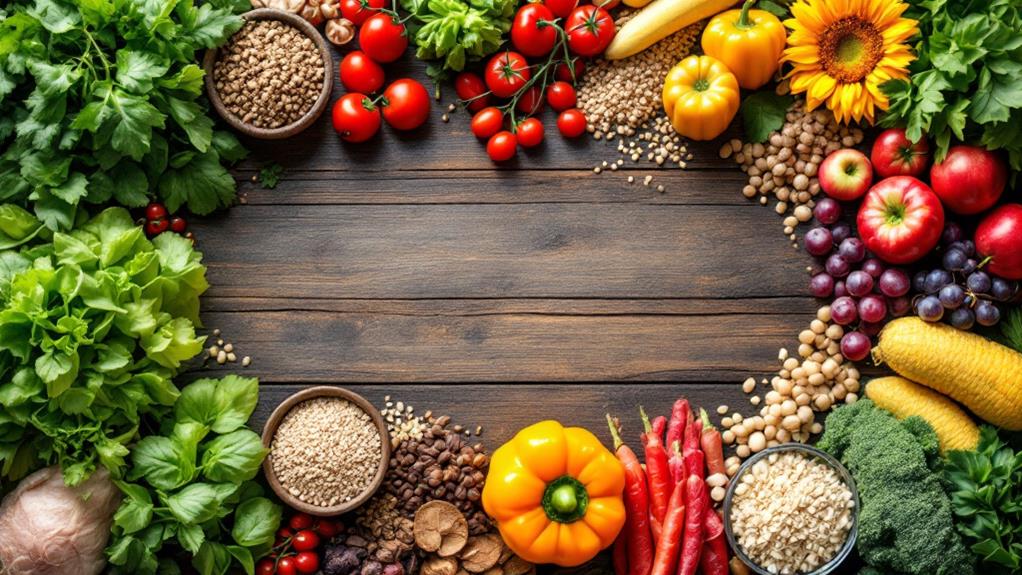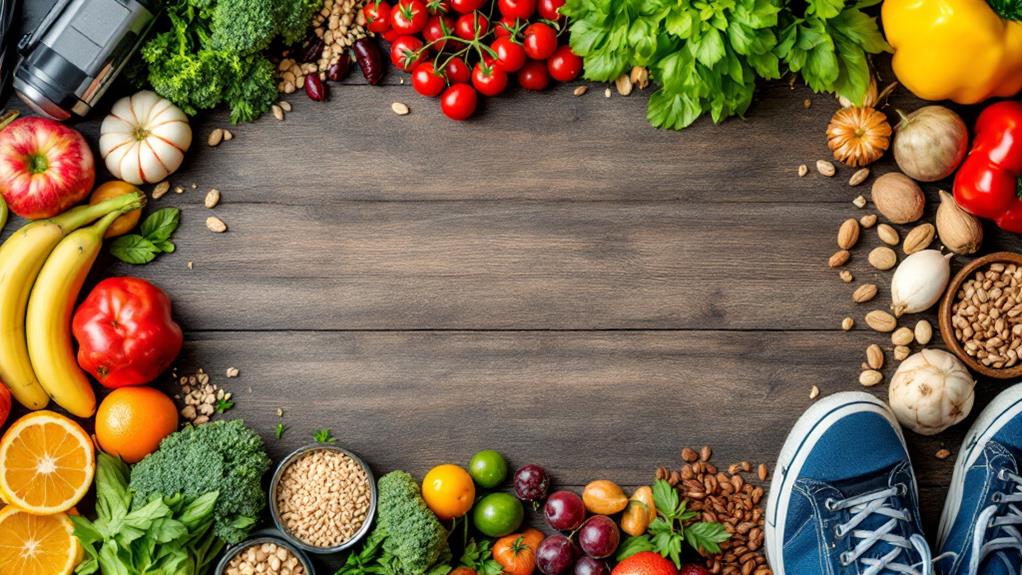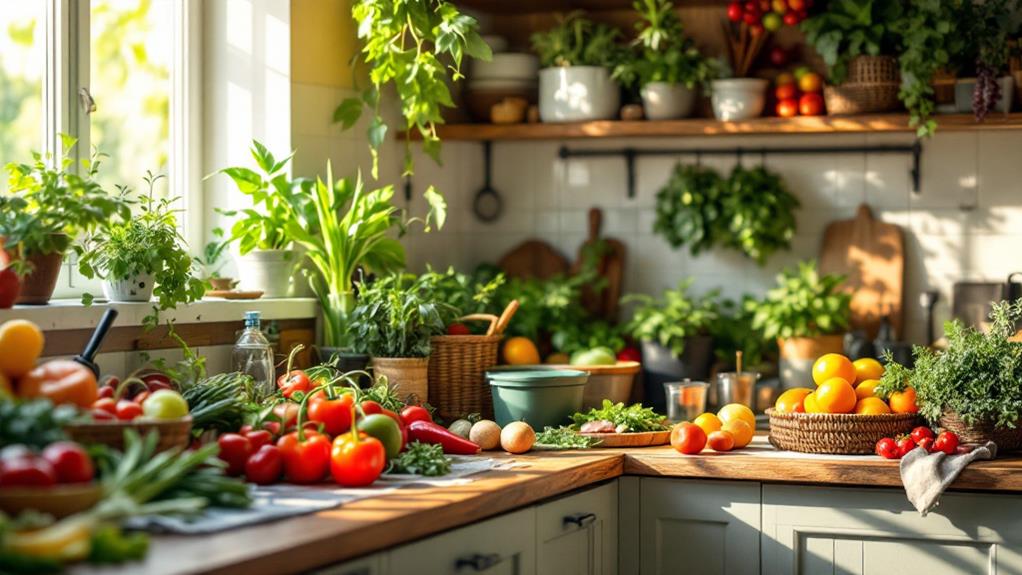How to Prepare Avocados: Tips for Ripening, Cutting, and Storing
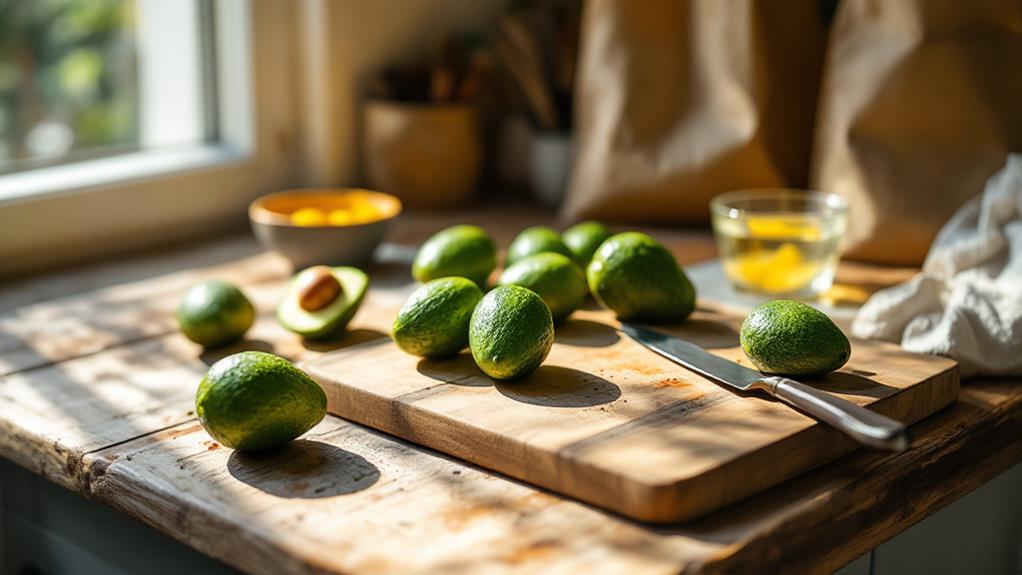
To prepare avocados, initially verify they're ripe; look for a dark color and gentle give. For ripening, keep them at room temperature or in a paper bag with a banana. When cutting, slice lengthwise and twist to separate, carefully remove the pit, and scoop the flesh. Use lemon juice to prevent browning. Store whole ripe avocados in the fridge to extend freshness by a few days. Keep cut avocados airtight with lemon juice and consume soon. For freezing, puree with lemon juice or freeze in chunks. There's more to uncover when you investigate further avocado preparation insights and tips.
Identifying Ripe Avocados
When you're picking avocados, knowing how to identify ripeness is key. Start by examining the avocado skin. Ripe avocados typically have a darker hue and may even look slightly wrinkled. Applying gentle pressure with your fingers is another effective method. If the avocado yields slightly, it's probably ripe. However, if it feels mushy and has deep indentations, it's overripe and should be used immediately or discarded.
To further check for ripeness, gently peel back the small stem at the avocado's top. If it comes off easily and reveals green flesh underneath, you've got a ripe avocado. On the other hand, if the stem resists or reveals brown flesh, it's either unripe or overripe.
For avocados that are firm with bright green skin, they are unripe and will need a few days at room temperature to reach perfect ripeness. Make sure to check these unripe avocados daily by applying gentle pressure to monitor their ripening progress. By understanding these signs, you'll always have perfectly ripe avocados ready to enjoy in your favorite dishes.
Ripening Techniques
After identifying ripe avocados, knowing how to ripen them properly can make all the difference in your culinary endeavors. Start by placing unripe avocados at room temperature, away from direct sunlight. This natural method takes about 4-5 days. To speed things up, place them in a paper bag with ethylene-producing fruits like bananas or apples. This accelerates the process, so check them daily to avoid over-ripening.
If you need to store avocados for later use, select slightly underripe ones. They'll have a longer ripening window, preventing them from spoiling too soon. Avoid putting unripe avocados in the fridge, as it halts the ripening process. Instead, keep them on the countertop until they reach the desired ripeness.
To monitor their progress, gently squeeze the avocados daily. A ripe avocado will yield slightly under pressure, whereas an unripe one will feel firm. Once your avocados are ripe, you can cut and store them. Apply lemon juice to prevent them from oxidizing and turning brown. Remember, proper ripening guarantees your avocados are perfect for slicing and using in your favorite dishes.
Cutting and Pitting Avocados
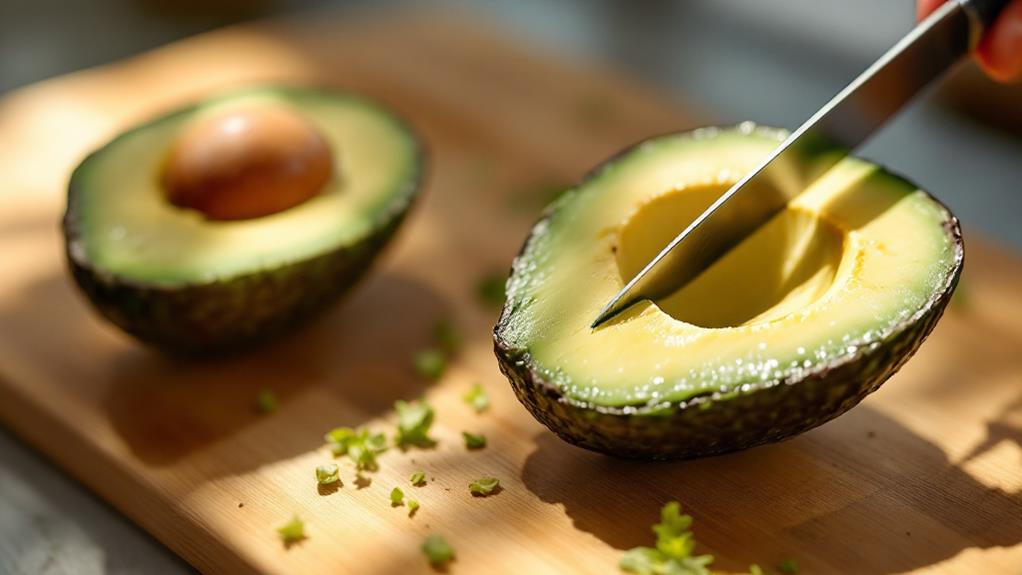
Mastering the art of cutting and pitting avocados guarantees you enjoy this creamy fruit without any hassle. To commence, place your avocado on a clean cutting board. Use a clean knife to cut the avocado in half lengthwise around the pit. Make sure to slice down to the seed, but avoid cutting through the skin. Once you've made the cut, gently twist the two halves apart.
Now, it's time to tackle the pit. There are two main ways to remove it safely. Initially, you can use a spoon to scoop out the pit. Simply slide the spoon under the pit and lift it out. Alternatively, you can tap your knife into the pit gently and twist until it releases. Always hold the half with the pit securely using a kitchen towel to stabilize it, reducing the risk of slipping and injury.
With the pit removed, you can easily slice the flesh while it remains in the skin. This technique creates clean pieces, making them ready for serving. Ultimately, use a spoon to scoop out the slices, and enjoy your perfectly prepared avocado.
Storing Whole Avocados
Once you've perfected the technique of cutting and pitting avocados, it's vital to know how to store them properly to maintain their freshness. When you store whole avocados, the approach depends on if they're ripe or unripe. Unripe avocados should be kept on the countertop at room temperature, away from direct sunlight. This allows them to ripen naturally. Opt for slightly underripe avocados if you intend to use them in a few days, giving them time to reach peak ripeness.
To keep your avocado fresh, daily checks for ripeness are significant. Gently squeeze the fruit; if it yields slightly, it's ready to eat. Once your avocados are ripe, move them to the refrigerator, ideally in the low-humidity crisper drawer. This slows down the ripening process, helping extend their shelf life for an extra 2-3 days without compromising quality.
Refrigeration is your ally in maintaining freshness, as it keeps ripe avocados in their prime condition longer. By understanding how to store whole avocados properly, you'll guarantee they're always fresh and perfect for your next culinary creation. So, store wisely and enjoy your avocados at their best!
Storing Cut Avocados
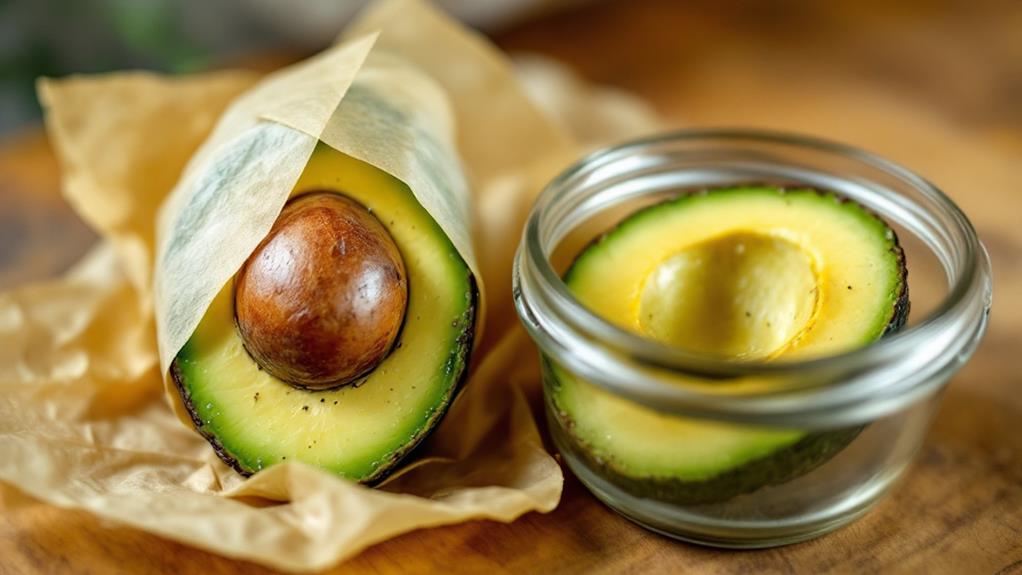
Cut avocados require thoughtful storage to keep them fresh and lively. You don't want them to turn brown and unappetizing too quickly. Here's how to effectively store cut avocados to maintain their freshness and delay spoilage:
- Sprinkle with Lemon Juice: To slow down oxidation, sprinkle a generous amount of lemon or lime juice on the cut avocado flesh. The acidity helps preserve the radiant green color and adds a hint of citrus flavor.
- Wrap in Plastic Wrap: Tightly wrap your cut avocado halves in plastic wrap. This limits their exposure to air, which is a major culprit in accelerating spoilage. Make sure the wrap is snug against the flesh to create an effective barrier.
- Refrigerate Immediately: Once you've prepped your cut avocado, pop it in the fridge right away. The cold temperature helps maintain freshness and extends the life of your avocado, although ripe ones usually last about a day.
- Check for Spoilage: Regularly inspect your stored cut avocados. Look for signs of spoilage, like a mushy texture or off-putting smell, and discard any that have gone bad.
Freezing Avocados
While storing cut avocados in the fridge helps maintain their freshness for a short period, freezing them is perfect for long-term preservation. To freeze avocados and guarantee they last up to five months, start by cutting the avocado, removing the pit, and scooping out the flesh. Puree the avocado with a splash of lemon or lime juice to prevent browning and preserve its lively color. This step is vital for maintaining the quality of the avocado during long-term storage.
Once pureed, transfer the mixture to a freezer bag. To guarantee the best quality, squeeze out as much air as possible before sealing the bag, creating an air-tight container. This technique helps prevent freezer burn and keeps your avocados fresh. If you prefer freezing avocado pieces instead of puree, cut the avocado into bite-sized chunks and freeze them on a parchment-lined plate until solid. Then, move them to a freezer-safe container for storage.
When you're ready to use them, thaw frozen avocados overnight in the refrigerator for the best texture. Alternatively, you can use the microwave's defrost setting if you're in a hurry. Enjoy your perfectly preserved avocados whenever you need them!
Avocado Recipe Ideas
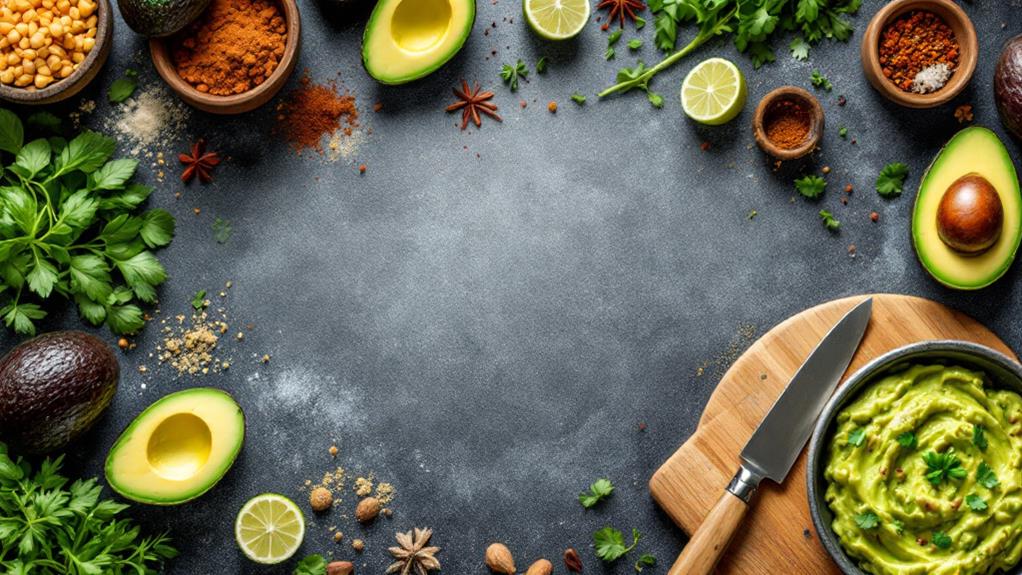
Avocado's versatility makes it a staple in many kitchens, offering a range of delicious recipe ideas for any meal. Regardless of you're looking to whip up a quick snack or a hearty meal, perfectly ripe avocados are the key ingredient. Here are some ideas to get you started:
- Guacamole: Make a classic dip by mashing a perfectly ripe avocado with lime juice, salt, diced onions, tomatoes, and cilantro. It's a flavorful enhancement to any snack or meal.
- Avocado Toast: Spread mashed avocado on toasted bread. Top it with poached eggs, radishes, or everything bagel seasoning for a nutritious breakfast or snack.
- Avocado Egg Salad: Mix mashed avocado with chopped hard-boiled eggs, mayonnaise, mustard, and seasonings. Use it as a creamy sandwich filling or salad topping.
- Avocado Pasta: Blend ripe avocados with garlic, olive oil, lemon juice, and herbs to create a creamy sauce. Toss it with your favorite pasta for a quick meal.
To keep avocados from turning brown and slow the ripening process, they should be stored in the refrigerator. By doing so, you can enjoy your avocado creations for longer, regardless if it's a revitalizing avocado smoothie or any of the above dishes.

